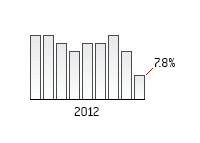Eyebrows Raised After National Unemployment Rate Drops to 7.8%
 Earlier today, the BLS ("Bureau of Labor Statistics") released the September unemployment report.
Earlier today, the BLS ("Bureau of Labor Statistics") released the September unemployment report. The BLS reported that the national unemployment rate dropped to 7.8% in September - a drop of 0.3%. The BLS also reported that total nonfarm payroll employment rose by 114,000 last month.
Wait a second, you are probably asking - how did the national unemployment rate drop 0.3% (which is a very big drop) when total nonfarm payroll employment rose by just 114,000? The answer to this question has many people howling this morning, alleging that the Obama administration is fudging the numbers in order to help his re-election campaign.
Jack Welch (former Chairman and CEO of General Electric), for instance, took to his Twitter account this morning to say:
"Unbelievable jobs numbers..these Chicago guys will do anything..can't debate so change numbers"
--
Let's look to the numbers to try and figure out what went on.
According to the BLS, "total employment rose by 873,000 in September, following 3 months of little change." Also, "the number of persons employed part time for economic reasons rose from 8.0 million in August to 8.6 million in September." These are people who want full time jobs but can only find part time work - so, according to the BLS, 600,000 people who want full time employment took a part-time job in September in order to help make ends meet.
According to the BLS, "the number of persons unemployed for less than 5 weeks declined by 302,000 over the month to 2.5 million".
The BLS also said in today's report that nonfarm payroll employment for July was revised from +141,000 to +181,000, while nonfarm payroll employment for August was revised from +96,000 to +142,000.
--
According to the BLS, the total civilian labor force was 155,063,000 in September.
The total number of "employed" in September was 142,974,000, up dramatically from 142,101,000 the month before. As multiple publications have noted, this was the highest such jump in nearly 30 years.
The total number of "unemployed" dropped from 12,544,000 to 12,088,000 in September. The total number of people not in the labor force declined from 88,921,000 to 88,710,000.
--
To try and get a handle on what took place in September, let's look to the U-6 unemployment rate, which is an "alternative measure of labor underutilization."
According to the BLS, the U-6 unemployment rate was unchanged in September at 14.7%, while the "official" unemployment rate dropped from 8.1% to 7.8%.
The U-6 unemployment rate counts a couple of groups of people as "unemployed" or "underemployed" that the "official" rate doesn't, including:
-people who are employed part time but want full time work
-people who are "marginally attached" to the workforce. These are people who are not currently looking for work but want a job and are available for a job and have looked for a job sometime in the past 12 months
So, if I want full-time work but have to settle for a 10 hour/week job working at a gas station, I am not counted as being "unemployed" in the "official" numbers. Or, if I have completely given up on finding a job because the current labor market is horrible, I am also not counted as being "unemployed" in the official unemployment numbers.
--
So, in closing, the 600k jump in people who want full-time work but were only able to find part-time jobs in September was the main reason why the national unemployment rate plummeted. Move these people to the "employed" column and the unemployment rate plummets.
The "official" unemployment rate plummeted today, but the U-6 rate, which is an alternative measure of labor underutilization, remained unchanged.
Source: BLS.gov - Employment Situation Summary (September)
Source: Historical Unemployment Rates
Filed under: General Knowledge



